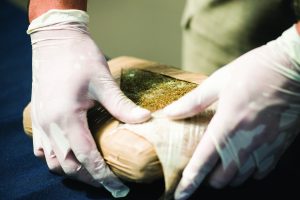
Across the globe, headlines continue to underscore a grim reality: the drug crisis remains a persistent and deadly threat to our communities. While the specific substances may vary by region, the consequences—overdose deaths, violent crime, and societal disruption—are universal. As police leaders, we are on the front lines of this crisis and must remain vigilant, informed, and united in our response.
The evolution of synthetic drug manufacturing has dramatically intensified the challenge. Fentanyl, in its many forms and potencies, has become a global problem. Alongside it, novel psychoactive substances—including designer benzodiazepines, novel opioids, and psychedelic drugs—are proliferating at an alarming rate. Moreover, polysubstance use is also on the rise, further complicating the problem. Fentanyl laced with xylazine; fentanyl-laced cannabis; and “Pink Cocaine,” a mix of MDMA, ketamine, and caffeine, are available in many areas. Alarmingly, over 40 percent of drug-impaired driving offenses included multiple drugs affecting the driver. Consequently, toxicology labs must learn about and identify new drugs based on evidence submissions and samples from coroners. Laboratories need to share information and collaborate in identifying substances on a global scale. What happens in one country frequently spreads to others. Sharing these resources enables a swifter response when a novel drug is identified in a new area.
Navigating this crisis is possible. Through efforts to identify trends, such as those from the Office of National Drug Control Policy (ONDCP), INTERPOL, the United Nations Office on Drugs and Crime, and the National Drug Early Warning Systems, police leaders can learn about emerging substances that could potentially impact their communities. In addition, the National Highway Traffic Safety Administration’s Drug Evaluation and Classification Program, managed by the IACP, is on the front lines for drug trends and identifying drug-impaired drivers. The arrest and collection of biological specimens as evidence allow laboratories to frequently identify these new drugs through toxicological analysis. Drug recognition experts (DREs) directly observe the effects of the drugs on a person and document them for adjudication in court. Equipped with this knowledge, we can better prepare for these threats, alert health authorities, and take steps to police the situation properly.
Data-informed decision-making is made possible only by good data. Tracking the use of substances and trends is enabled by criteria established by responsible authorities. For example, the ONDCP tracks the mortality frequency associated with an increase or decrease in the presence of drugs. When there is an increase in deaths attributed to a single or a combination of psychoactive substances of at least 5 percent, it becomes a drug of interest and undergoes further monitoring. If the mortality rate shows an increase of 10 percent, it is rightly considered a drug of concern. Police leaders in the affected area should begin preparing for the spread of the drug in their community. If there is an increase of 15 percent or more, it is considered a drug threat.
Saving lives is the priority, and taking steps early can make a critical difference.
Several strategies will aid police leaders in navigating the drug crisis. Understanding how the drug affects users will help identify future cases. DREs, street-level drug enforcement officers, and emergency room physicians are excellent sources for this information. Treatment centers and mental health counselors must become familiar with the drug to know the mechanism of action for proper treatment. By identifying the areas of the brain affected by the drug, clinicians can prescribe treatment options that will more effectively benefit the patient. Further, helping the person cope with any mental health illnesses that encourage the use of drugs will help to prevent future use of these harmful substances.
 When a drug threat in the region has been identified, immediate steps should be taken to mitigate the potential harm of this substance. Mental health counselors should become aware of the drug, and medical staff should prepare for emergency room visits. Police leaders should ensure their staff participate in a community-wide, cross-disciplinary network of physicians, treatment providers, police, and emergency responders to share identified drug threats. Each of these professions can prepare in advance to treat patients should they encounter them in an emergency or counseling setting. Understanding the potency of a substance is critical for first responders. Toxicologists help identify the power of the drug and its levels of harmfulness. Potential counteractive measures, such as narcotic antagonists, may prove helpful in overdose situations. Saving lives is the priority, and taking steps early can make a critical difference.
When a drug threat in the region has been identified, immediate steps should be taken to mitigate the potential harm of this substance. Mental health counselors should become aware of the drug, and medical staff should prepare for emergency room visits. Police leaders should ensure their staff participate in a community-wide, cross-disciplinary network of physicians, treatment providers, police, and emergency responders to share identified drug threats. Each of these professions can prepare in advance to treat patients should they encounter them in an emergency or counseling setting. Understanding the potency of a substance is critical for first responders. Toxicologists help identify the power of the drug and its levels of harmfulness. Potential counteractive measures, such as narcotic antagonists, may prove helpful in overdose situations. Saving lives is the priority, and taking steps early can make a critical difference.
The next level of priority is removing the threat from the community. Street-level drug enforcement can help identify sources for the drug and the mechanisms of trafficking it into society. Traditional and nontraditional drug interdiction methods can then be deployed to rid the problem at its source, which may require the involvement of additional agencies and staff. Learning the transportation method, the location of manufacture, and the source of the chemicals can all play an essential role in mitigating the drug threat.d
Please cite as:
Ken A. Walker, “Navigating the Drug Crisis,” President’s Message, Police Chief 92, no. 7 (July 2025): 6–7.


